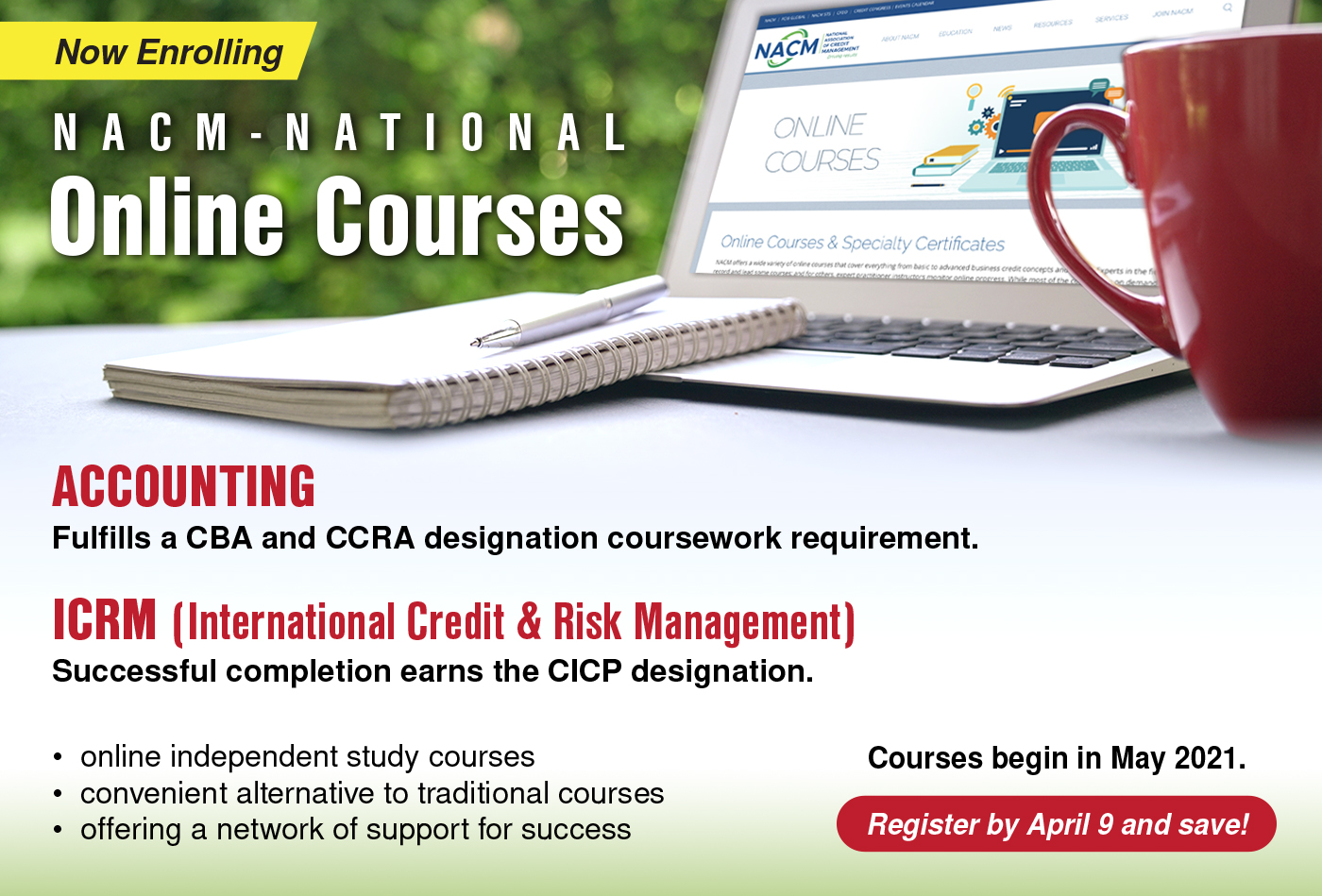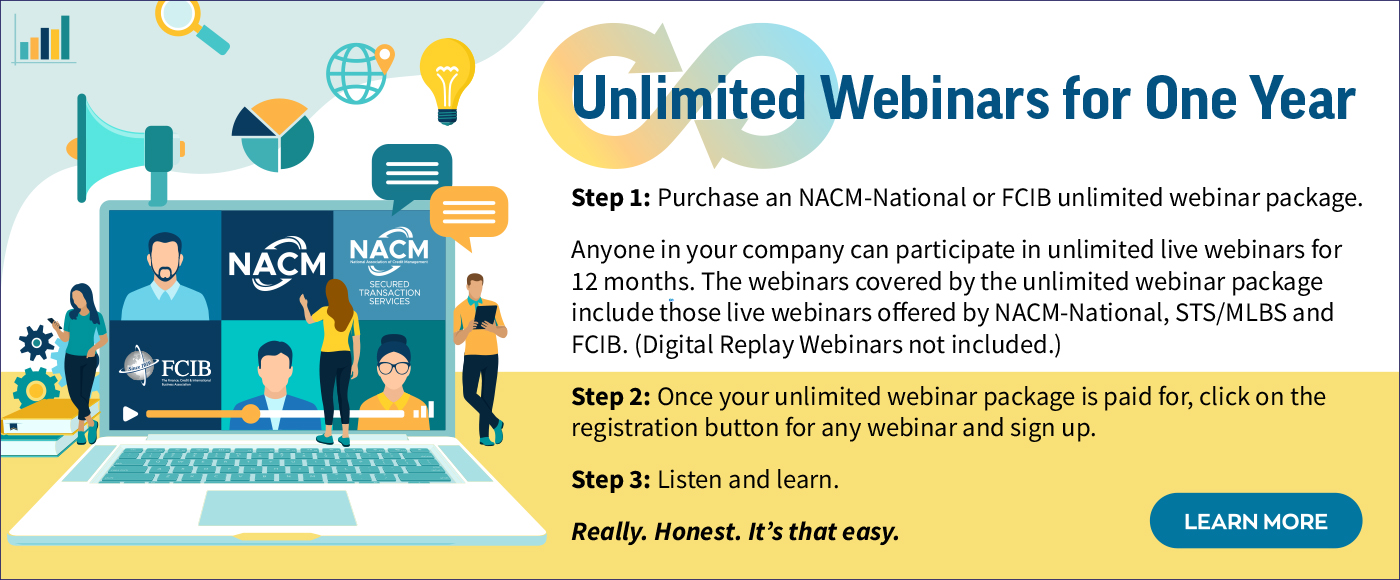eNews March 11
In the News
March 11, 2021
Will US Economy Lead the Way on Global Growth?
Chris Kuehl, Ph.D., NACM economist
The current expectation is that global growth will rebound in the next several months—perhaps hitting a rate of more than 6.0%. While this is not a record level of activity, it is better than what has been recorded in the last few years and certainly better than last year.
The major driver for this growth will be from the U.S. That is a marked contrast from the last recession. The more that economists examine the recession in 2008 and the one in 2020, the more obvious it has been that the former collapse was far worse than the latter one, especially as far as the US is concerned.
The financial sector failure led to the 2008 recession. This led to a very slow and halting recovery. It was well into the decade before there was anything approaching a real rebound. At the moment, it appears that the recovery from the 2020 debacle will be swift. Most of the projections are showing what amounts to a classic “V” recovery with growth slated to be in excess of what it was at the start of the recession. The other contrast between the recession in 2008 and the one in 2020 is that the engine of global growth is likely to be the U.S. and not China as was the case in 2008.
As powerful as China has become in the last 10 to 20 years, the fact is the U.S. still has the world’s largest economy and one that is a third larger than that of China. Furthermore, far more nations are dependent on the U.S. than are dependent on China. The world may buy a lot from China, but it doesn’t sell nearly as much to China as it sells to the U.S.
Both nations are expected to grow at approximately the same rate, China at between 7.0% and 8.0% and the U.S. between 6.5% and 7.5%. If the two are matched closely in terms of growth rate, the additional size of the U.S. market makes it more important to global growth in general.
This has a whole host of implications, and there are more than a few caveats. The factor that will play the biggest role will be the pace of recovery from the pandemic. Data at the moment is promising as progress continues as far as vaccine distribution. However, concerns stem from decisions by some states to reduce or eliminate restrictions. Are these lifting too soon?
The fear is another surge in the virus will take place as the more easily transmitted version has taken hold in the U.S. and could spread fast. This would reverse much of the progress as far as number of cases, number of hospitalizations and numbers of fatalities. The only thing worse for the economy than a delayed resumption of normal activity would be the need to institute another lockdown.
The impact on trade relations could be significant as well. If the U.S. is growing at a rate this rapid, we are looking at numbers that are nearly three times better than the 20-year norm. The U.S. has been growing at around 2.5% per year for the last 20 to 25 years, and now it is expected to hit at least 6.0%. That is going to translate to a lot of demand.
Every nation on the planet is going to want to get a piece of that growth. That gives the U.S. an unusual amount of trade leverage. If access is granted to these imports, it will offer the U.S. an opportunity to get trade access in return. There will also be a significant increase in U.S. demand for commodities to satisfy the demands of industry as it sees a resumption of demand. One question that will hang over the year of recovery will concern how consumers choose to spend their money. If the rush is back to services, there might actually be a decline in demand for manufactured goods and even imports.
Nothing about this recession was normal. As has been pointed out numerous times, it was an imposed recession, a lockdown designed to deal with another problem. As the pressure begins to lift, the odd nature of this recession will persist. We went into this situation in chaos, and we will exit in just as much chaos. Every state will react differently. Some states have already lifted restrictions and mandates, and some have reimposed them. Most are somewhere in the middle. Millions of people have abandoned any pretense of complying, and millions are still hunkered down. As more and more people get vaccinated, the impatience will grow even before the risk fades; and at some point, a level of threat will become acceptable. The virus will never go away; it will simply be less prevalent, and the decision will have to be made to tolerate some impact.
Five-Year Fraud Scheme Raises Questions
About Scam Protection
Bryan Mason, editorial associate
The sentencing of former MGT Construction executive, Patrick Lindsey, for a five-year fraud scheme has Chris Ring, of NACM’s Secured Transaction Services, considering ways material suppliers or subcontractors could have protected themselves better in this situation.
Over the five-year period, Lindsey served an integral role in the large-scale corporate accounting fraud scheme designed to conceal the fact that MGT Construction was more than $20 million in debt.
Lindsey’s fraudulent actions went undetected from 2011 to 2016; and he even was promoted to vice president during this time frame. Ultimately, his actions were the impetus for the firm’s bankruptcy liquidation in 2018.
“That deceit not only maintained the defendant’s job and padded his annual compensation package, but it also proved devastating to the individuals who worked on MGT Construction projects and were left holding the bag after the fraud scheme was uncovered and the company subsequently collapsed,” said Raj Parekh, acting U.S. attorney for the Eastern District of Virginia.
According to court documents, Lindsey engaged in a fraudulent accounting scheme that sought to conceal MGT’s true financial position through job-cost manipulations within the company’s accounting software system.
Lindsey had primary day-to-day management of the accounting scheme, which involved the regular movement of job-cost invoices from nearly finished projects to more recent construction projects. This cost-shifting falsely inflated profit margins and concealed losses, which generated a wholly inaccurate picture of MGT’s profitability. MGT and its parent company submitted the products of these fraudulent accounting manipulations as part of MGT’s application packages to banks and insurance companies for lines of credit and bonding coverage.
During the conspiracy, Lindsey moved or deleted thousands of job cost invoices, concealing the fact that, by the time the scheme was uncovered in November 2016, MGT Construction was over $20 million in debt. When the accounting fraud was exposed, MGT Construction owed millions of dollars in outstanding invoices that it could not pay to dozens of contractors, subcontractors, and vendors who had provided their services or products to MGT Construction. As a result, MGT filed for Chapter 7 bankruptcy in early 2018.
A consistent influx of new projects is critical to continue this type of scheme. “This necessity for continued accounting manipulation meant that MGT operated under the perverse incentive of acquiring new projects at any cost—even if that required MGT to submit deliberately under-valued project estimates in order to ensure that MGT would underbid other construction firms when competing for new projects,” the U.S. District Court for the Eastern District of Virginia wrote in its statement of facts.
Prosecutors don’t believe Lindsey acted alone, but no one else has been charged as of yet.
The fact that only Lindsey reportedly dispersed funds should serve as a red flag, Ring said. “He was savvy; he must have been a skilled manipulator. But when only one person controls how the money from these projects is distributed, that’s a problem.”
Under a plea agreement, Lindsey agreed to pay $18.7 million to companies hindered by the fraud. Of that amount, MGT’s parent company, Morton G. Thalhimer, is claiming $14.9 million after repaying debts on its behalf.
It is not clear whether material suppliers were getting paid or not, but Ring emphasized how important it is for material suppliers to practice their lien rights, as well as using a Section 43-11 notice.
Under the state of Virginia’s Section 43-11 notice “an owner or general contractor could be made personally liable to subcontractor, laborer or materialman.”
The use Section 43-11 makes the owner or general contractor liable for the debt, Ring said. While the section serves to protect material suppliers and others, it has been under used, he added. The code states “two notices are required to perfect the Section 43-11 requirements.”
In addition, Section 43-11 states “a general contractor’s liability to a sub-tier subcontractor or supplier is limited to the amount the general contractor owes his subcontractor at the time of filing. It is important that suppliers and subs provide notice to the owner and prime sooner rather than later before funds are exhausted.”
Despite these laws being in place, Ring explains, “There’s no way to completely eliminate fraud; we just have to mitigate it as best we can. Sticking to your rights is a must in order to keep pressure on general contractors to make sure everyone is being paid and to put yourself in the best position as possible in case of nonpayment.”
Avoid Getting Blindsided: Turn Your Managers into Leaders
Marlene Chism, Marlene Chism Consulting
If you have managers or supervisors below you, it’s important to bring awareness to how your managers are leading. I’ve worked with many senior leaders blindsided by toxic behavior that eventually led to litigation, simply because they thought their managers were doing a great job.
Here’s what happens: The midlevel manager manages up very well, gets along with the upper echelon, getting things done in a polished professional manner. Yet in their own departments, they show up differently. They have control issues. They micromanage their supervisors. They contribute to gossip, throwing others under the bus in front of colleagues, or they allow and participate in profanity.
In short, you are seeing their best, but they set a bad example for their front-line supervisors and managers. Sometimes a consultant can shine light on why internal issues don’t get adequately resolved. If you’re not ready to work with a consultant, you can start meeting informally with employees at various levels to hear about their experience.
Listen for red flags that highlight three areas of concern: psychological safety, autonomy and growth.
Psychological Safety
When I worked in manufacturing, workplace safety was a priority. Earplugs protected us from hearing loss, and goggles protected our eyes when cleaning equipment. We practiced lock-out-tag-out if we had to fix a jam, and we had yearly OSHA meetings.
But we never talked about the importance of psychological safety. Psychological safety is more than about trust. Psychological safety is the freedom to express yourself and to learn without feeling the threat of judgment, harsh criticism or threats to your identity and value as a person. As a top-level leader, you need to be able to quickly identify threats to psychological safety.
Red flags
- Criticizing out loud instead of in private
- Emails with all-caps or name-calling
- Using sarcasm to shut someone down
- Confusion about performance
In today’s climate—where employees have to adapt to uncertainty, survive threats of a global pandemic and navigate through the ever-changing political and social climate—creating an environment of psychological safety has never been more important.
Autonomy
Command-and-control leaders often struggle to provide autonomy to the leaders reporting to them. Autonomy is the ability to make decisions without always having to constantly seek agreement or get something to be “signed off” on.
I worked with a leader who simply didn’t trust the decision-making abilities of his supervisors, and even though the supervisors had the title, they had very little authority to get things done. On the surface, this seemed like a lack of clarity in role and job description. In reality, it was the inability of the director to let go and to trust the decision-making processes already in place.
Red flags
- Micromanaging
- Frustrated managers
- Lack of engagement
- Bottlenecks (always waiting for approvals)
One way to leverage resources is to formalize a decision-making process first. Then, make sure the front-line and mid-level leaders are skilled and fully understand the decision-making process, and that their decisions will be supported by their boss.
Growth Opportunities
Leaders who get elevated to a higher level sometimes struggle to let go of their old identity where they were brilliant and gained a reputation for their expertise. It’s awkward letting go to allow others to shine. Often, there’s an inner conflict about teaching someone else all the secrets, then watching them get the glory. It’s especially difficult if the newbie has some disruptive ideas and excels quickly.
No matter how enlightened, sometimes we human beings simply struggle with the green-eyed monster of envy.
Red flags
- Negative evaluations
- Unwanted turnover
- Lack of coaching
- Redundant rework
Part of good leadership is fostering an environment where employees get opportunities to grow. If you’re seeing too many negative evaluations that never improve, pay attention. What’s required of the leader in charge is the ability to coach others and to let go of certain things that once brought personal recognition and value.
Conclusion
The higher up you are in an organization the easier it is to be blindsided by a complaint that eventually turns into litigation. Staying in touch with various levels through the organization ensures accountability.
You can offer mini-surveys or 360-degree management evaluations, as well as intermittent one-on-one conversations that tell you where you need additional leadership development and outside support.
Reprinted with permission by Marlene Chism. Article originally published via SmartBrief.
Marlene Chism is a consultant, international speaker, and the author of “Stop Workplace Drama” (Wiley 2011), “No-Drama Leadership” (Bibliomotion 2015) and an advanced practitioner of Narrative Coaching. She is a recognized expert on the LinkedIn Global Learning platform. Connect with Chism via LinkedIn or at MarleneChism.com.
 |
|
Financial modeling helps credit professionals make predictions on how a company’s financial statements could change under forecast assumptions. Likewise, forecasting is an essential tool to assess the risk of a firm. Together these tools become even more imperative to use when evaluating a company's credit risk using data collected prior to sudden and significant shifts in country, macro-economic or industry risks such as the impact of Covid-19. Join Nexus Specialty’s Antje Seiffert-Murphy, CFA, as she works through a forecasting example with varying assumptions and addresses alternative ways to research and understand risk. Antje will also discuss potential questions that a vendor might raise to understand a buyer’s risk better. |
A wise, time-traveling scientist once said: “Your future hasn’t been written yet. No one’s has. Your future is whatever you make it. So, make it a good one.”
Yes, this scientist, Dr. Emmett Brown from the Back to the Future film series, is fictional. However, his point is that nothing is set in stone; there are ways to create a bright future.
In her upcoming webinar, Using Financial Modeling to Assess Risks Before They Happen, Antje Seiffert-Murphy, CFA, of Nexus Specialty Inc., will translate this concept for companies. Unlike the time machine Dr. Brown and his companion Marty McFly use to learn about the future, Seiffert-Murphy will discuss how companies can use financial modeling to forecast financial performance and prepare for potential risks.
“Financial modeling is about taking a company’s historical financials and making assumptions around what the future might look like to then forecast financial performance in the year ahead,” Seiffert-Murphy said. “It could be a relatively simple model or it could be a more complex model,” but each requires similar components.
Companies need income statements, balance sheets and cashflow statements in USD amounts in addition to at least three years of historic annual financials, she said. Then, it’s about developing assumptions.
Some credit professionals might wince at “assumptions” because assumptions in credit can lead to trouble, such as assuming a customer is creditworthy or assuming a customer will pay on time, she added. However, financial modeling assumptions are more like “broad considerations” similar to a country’s or industry’s growth prospects and the availability of liquidity.
“What we’re doing here is to predict; we need to assume the input factors,” Seiffert-Murphy said. “Based on the growth of the economy and depending on the sector, I might assume and assess sales growth by 2%. It’s something I don’t know, but it’s something I determined based on the research I’ve been doing. Developing assumptions is all about the research I do and the observations I make.”
Then, you have conversations to support the assumptions. As part of the forecasting and assumptions around forecasting, companies must introduce scenario assessments such as how the forecasted financials would look in worst-case and best-case scenarios. It is also necessary to think about the company’s ecosystem, both internally and externally.
The outcome is only as good as the input; assumptions can steer the outcome in either direction. For example, actual financials would not provide companies with insight into their 2020 performance due to the pandemic. Therefore, their assessment and forecasting must include how things may have looked in 2020 and how things will look in 2021.
“It gives you an insight into the forward-looking expectations,” Seiffert-Murphy said. “With historic financials, we only see the back of the road. Financial modeling gets us into the car to drive forward and see the possibilities, giving us invaluable insight into the credit risk.”
Credit professionals want to use any other tools and analytical research in their assessment, she added.
By tuning into Antje Seiffert-Murphy’s webinar, “Using Financial Modeling to Assess Risks Before They Happen,” on March 25, participants will learn even more about financial modeling, such as how models are created using Microsoft Excel and how financial modeling can be used to assess the impact of COVID-19.
|
Upcoming Webinars |
|
Mar 15 |
Recent Stimulus Legislation's Changes to the Bankruptcy Code Speakers: Bruce Nathan, Esq. and Eric Chafetz, Esq., Lowenstein & Sandler |
| Working in Sync: How Eleven Dartmouth Athletes Propelled Their College Sports Experience into Professional Excellence Chat with Author Whit Mitchell |
Mar 18 |
|
Mar 24 |
Protecting Liens & Bond Collateral in Minnesota
Speaker: Jim Sander, Esq., Larkin Hoffman's Real Estate Litigation Group |
| Using Financial Modeling to Assess Risks Before They Happen Speaker: Antje Seiffert-Murphy, CFA, Nexus Specialty |
Mar 25 |






